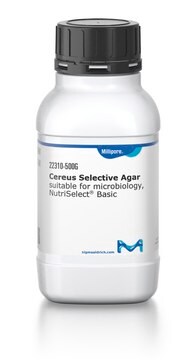1.05406
Baird-Parker Agar
GranuCult® prime, ISO 6888, ISO 22178, FDA-BAM, APHA, granular, pack of 500 g
Synonym(s):
GranuCult® Baird-Parker agar (base), Staphylococcus selective agar, Staphylococcus selective agar acc. to BAIRD-PARKER (base)
About This Item
Recommended Products
agency
APHA
FDA-BAM
ISO 22178
ISO 6888
Quality Level
sterility
non-sterile
form
granular
packaging
pack of 500 g
manufacturer/tradename
GranuCult® prime
technique(s)
microbe id | specific enzyme detection: suitable
microbiological culture: suitable
pH
6.8 (37 °C, 58 g/L in H2O)
solubility
58 g/L
bulk density
570 kg/m3
application(s)
food and beverages
microbiology
storage temp.
15-25°C
suitability
Staphylococcus spp.
Looking for similar products? Visit Product Comparison Guide
General description
Application
Linkage
Analysis Note
Appearance (color): yellowish-brown
pH-value (25 °C): 6.6 - 7.0
Solidification behaviour (2 hrs., 45 °C): liquid
Growth promotion test in accordance with the current version of DIN EN ISO 11133.
Inoculum on reference medium (Staphylococcus aureus ATCC 6538 (WDCM 00032)):
Inoculum on reference medium (Staphylococcus aureus ATCC 25923 (WDCM 00034)):
Colony count (Staphylococcus aureus ATCC 6538 (WDCM 00032)):
Colony count (Staphylococcus aureus ATCC 25923 (WDCM 00034)):
Recovery on test medium (Staphylococcus aureus ATCC 6538 (WDCM 00032)): ≥ 50 %
Recovery on test medium (Staphylococcus aureus ATCC 25923 (WDCM 00034)): ≥ 50 %
Growth (Escherichia coli ATCC 8739 (WDCM 00012)): no growth
Growth (Escherichia coli ATCC 25922 (WDCM 00013)): no growth
Growth (Staphylococcus saprophyticus ATCC 15305 (WDCM 00159)): no limit
Growth (Staphylococcus epidermidis ATCC 12228 (WDCM 00036)): no limit
Growth (Enterococcus hirae ATCC 8043 (WDCM 00089)): no limit
Growth (Proteus mirabilis ATCC 29906 (WDCM 00023)): no limit
Colonies (Staphylococcus aureus ATCC 6538 (WDCM 00032)): Black or grey colonies with clear halo
Colonies (Staphylococcus aureus ATCC 25923 (WDCM 00034)): Black or grey colonies with clear halo
Colonies (Staphylococcus saprophyticus ATCC 15305 (WDCM 00159)): Black or grey colonies without clear halo
Colonies (Staphylococcus epidermidis ATCC 12228 (WDCM 00036)): Black or grey colonies without clear halo
Colonies (Enterococcus hirae ATCC 8043 (WDCM 00086)): Black or grey colonies without clear halo
Colonies (Proteus mirabilis ATCC 29906 (WDCM 00023)): Brown or black colonies without clear halo
Incubation:
24 ± 2 to 48 ± 2 hours at 37 ± 1 °C aerobic
E.coli 48 ± 2 hours at 37 ± 1 °C aerobic
A recovery rate of 50 % is equivalent to a productivity value of 0.5.
The indicated colony counts result from the sum of a triple determination.
Reference media: Tryptic Soy Agar
Other Notes
Footnote
The designations basic, plus, or prime are added to indicate the quality control level, from basic quality control to standard QC plus to prime for full regulatory compliance.
Legal Information
signalword
Warning
hcodes
Hazard Classifications
Eye Irrit. 2 - Skin Sens. 1
Storage Class
11 - Combustible Solids
wgk_germany
WGK 3
Certificates of Analysis (COA)
Search for Certificates of Analysis (COA) by entering the products Lot/Batch Number. Lot and Batch Numbers can be found on a product’s label following the words ‘Lot’ or ‘Batch’.
Already Own This Product?
Find documentation for the products that you have recently purchased in the Document Library.
Customers Also Viewed
Articles
Microbial culture media is available in both powdered and granulated forms. This article compares the characteristics of each culture media format with regards to safety, handling and convenience.
Our team of scientists has experience in all areas of research including Life Science, Material Science, Chemical Synthesis, Chromatography, Analytical and many others.
Contact Technical Service









